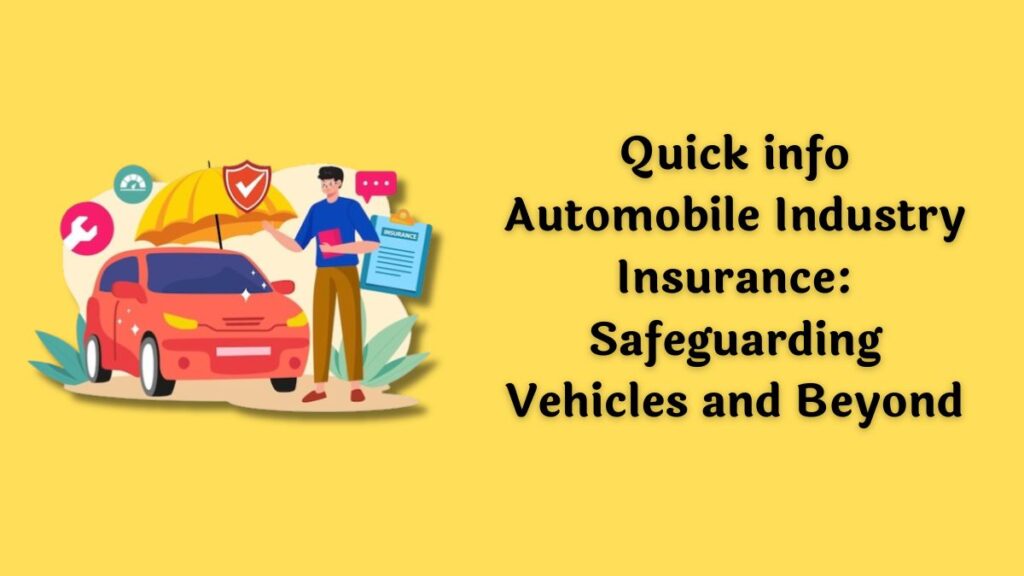The automobile industry is a vital pillar of the American economy, driving innovation, employment, and mobility. With millions of vehicles traversing roads daily, risks are inherent, ranging from accidents to thefts and natural disasters.

In this dynamic landscape, automobile industry insurance emerges as a cornerstone, offering protection to vehicles, businesses, and individuals. This comprehensive guide delves into the nuances of automobile industry insurance, elucidating its significance, types, key players, and emerging trends.
Understanding Automobile Industry Insurance
Vehicle industry insurance, also known as auto insurance, encompasses a range of policies designed to mitigate financial losses associated with vehicle-related incidents. These incidents include accidents, thefts, vandalism, natural disasters, and liability claims. Insurance acts as a financial safety net, providing coverage for vehicle repairs, medical expenses, legal fees, and third-party damages.
Types of Automobile Industry Insurance
Vehicle Insurance
Vehicle insurance, the cornerstone of automobile industry insurance, protects individual vehicles against various risks. This insurance typically includes collision coverage, which pays for damages resulting from accidents, and comprehensive coverage, which covers non-collision incidents such as theft, vandalism, and natural disasters.
Commercial Insurance
Commercial insurance caters to businesses involved in the automobile industry, including dealerships, repair shops, and rental agencies. These policies provide coverage for business-owned vehicles, property damage, liability claims, and business interruptions.
Liability Insurance
Liability insurance safeguards policyholders against legal liabilities arising from accidents where they are at fault. This includes bodily injury liability, covering medical expenses and legal fees for injured parties, and property damage liability, compensating for damage to third-party properties.
Comprehensive Insurance
Comprehensive insurance offers broad protection against a myriad of risks, including theft, vandalism, fire, floods, and storms. This coverage extends beyond accidents, providing financial security against unforeseen events that could damage or destroy vehicles.
Key Players in the Automobile Industry Insurance Market
The automobile industry insurance market comprises a diverse array of stakeholders, including insurance companies, brokers, agents, and regulatory bodies. Major players in this market include:
- Insurance Companies: Leading insurers such as Geico, Progressive, State Farm, and Allstate dominate the automobile insurance landscape, offering a wide range of policies tailored to individual and commercial needs.
- Insurance Brokers: Insurance brokers act as intermediaries between insurance companies and policyholders, helping clients navigate policy options, obtain quotes, and file claims.
- Insurance Agents: Insurance agents represent specific insurance companies and sell their products directly to consumers. They provide personalized guidance and support throughout the insurance process.
- Regulatory Bodies: Regulatory bodies such as the National Association of Insurance Commissioners (NAIC) oversee the automobile insurance industry, ensuring compliance with regulations and protecting consumer interests.
Emerging Trends and Innovations
The automobile industry insurance landscape is constantly evolving, driven by technological advancements, changing consumer preferences, and regulatory reforms. Some notable trends and innovations include:
- Usage-Based Insurance (UBI): UBI utilizes telematics technology to track driving behavior and adjust insurance premiums accordingly. This pay-as-you-drive model rewards safe driving habits and offers potential cost savings for policyholders.
- Autonomous Vehicles: The rise of autonomous vehicles presents new challenges and opportunities for the insurance industry. Insurers are exploring innovative solutions to assess risks, determine liability, and underwrite policies for self-driving cars.
- Digital Transformation: Insurers are embracing digital technologies to streamline processes, enhance customer experiences, and offer personalized insurance solutions. Online platforms, mobile apps, and digital claims processing are becoming standard features in the industry.
- Cyber Insurance: With the increasing connectivity of vehicles, cyber threats pose a significant risk to the automobile industry. Cyber insurance policies are emerging to protect against data breaches, ransomware attacks, and other cyber risks.
Must Read:-
- How to Get Geico Car Insurance? Best Ways to find best Insurance in 2024
- How to Find Direct Auto Insurance? Best Way’s to Secure Your Plan in 2024
FAQs about Automobile Industry Insurance
Q1: Is automobile insurance mandatory in the United States?
A: Yes, most states require drivers to carry a minimum amount of auto insurance to legally operate a vehicle on public roads.
Q2: What factors influence auto insurance premiums?
A: Auto insurance premiums are determined by various factors, including the driver’s age, driving record, location, vehicle make and model, and coverage options.
Q3: Can I save money on auto insurance?
A: Yes, there are several ways to lower your auto insurance premiums, such as bundling policies, maintaining a clean driving record, opting for higher deductibles, and taking advantage of discounts.
Conclusion
Automobile industry insurance plays a crucial role in safeguarding vehicles, businesses, and individuals against unforeseen risks and liabilities. As the automotive landscape continues to evolve, insurance providers must adapt to emerging trends, embrace digital transformation, and innovate to meet the evolving needs of policyholders. By understanding the nuances of automobile industry insurance and staying informed about industry developments, stakeholders can navigate the complexities of auto insurance with confidence and peace of mind.